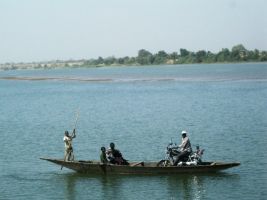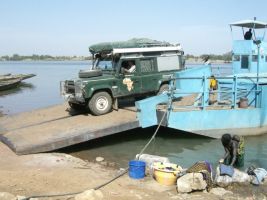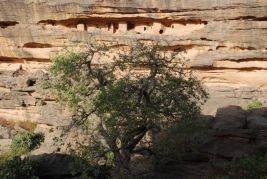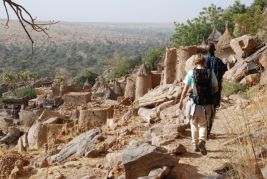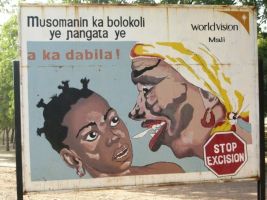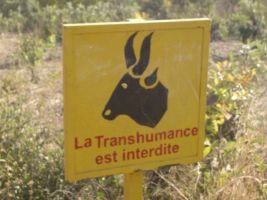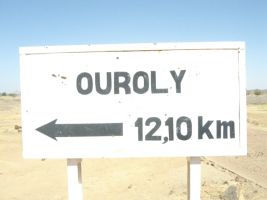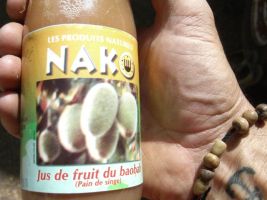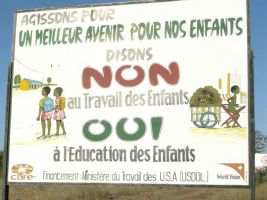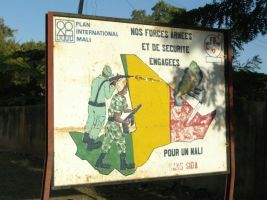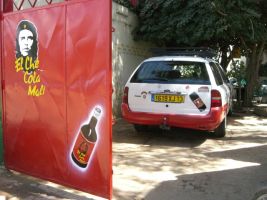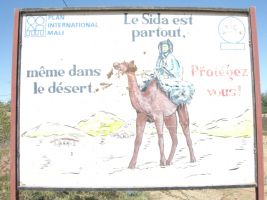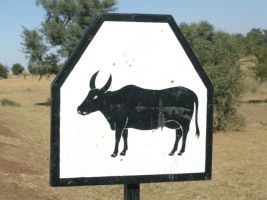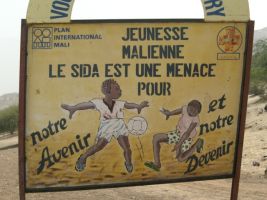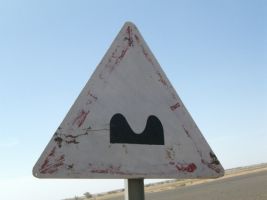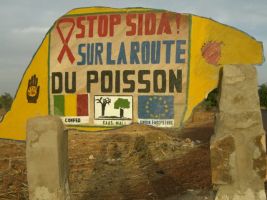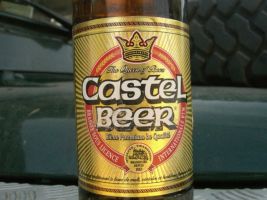
 Italia
Italia France
France Spain
Spain Morocco
Morocco Mauritania
Mauritania Senegal
Senegal Mali
Mali Burkina
Burkina Ghana
Ghana Togo
Togo Benin
Benin Nigeria
Nigeria Cameroon
Cameroon Gabon
Gabon Sao Tomè
Sao Tomè Gabon 2
Gabon 2 Congo
Congo Congo DCR
Congo DCR Angola
Angola Namibia
Namibia Sud Africa
Sud Africa Namibia 2
Namibia 2 Botswana
Botswana Zimbabwe
Zimbabwe Botswana 2
Botswana 2 Sud africa 2
Sud africa 2 Swaziland
Swaziland Mozambico
Mozambico Malawi
Malawi Tanzania
Tanzania Rwanda
Rwanda Uganda
Uganda Kenya
Kenya Etiopia
Etiopia Sudan
Sudan Egitto
Egitto Libia
Libia Tunisia
Tunisia Malta
Malta
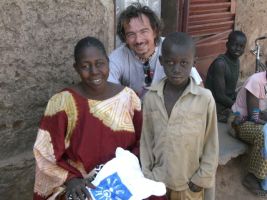
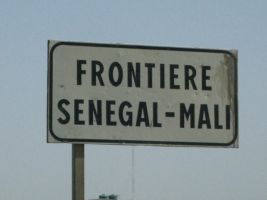
We enter Mali – 26 Dec 2007
We do not encounter any problems with police and customs officers whilst going through customs. Only a slight problem with the “Carnet de Passage”; on the back cover there is a list of countries where the carnet is recognized:, among the 10 African countries Mali is missing! It is an old cover that the ACI (Automobile Club Italia) gave us. We paid 160 euros for this invalid document. Before you leave, check that all the states you want to visit are on it.
Hey, someone in Modena….can you tell the ACI to change their out-of-date covers??
A Customs Officer…and a Gentleman….
An officer is looking at our Carnet de Passage. He’s turning the document up-side-down, back to front, this way and that…up-side down again…it looks like it’s the first time he’s seen anything like it! Meanwhile, I’m starting to get a little concerned and I can feel myself breaking out into a sweat. The air conditioning is not helping, its just making my sweaty shirt feel quit unpleasant. He continues with his examination of the document, “no, the other way round”, I want to say; “it’s supposed to be the other way round ” …now what is he looking at? That’s it, I just can’t contain myself any longer, I’ve got to say something. As I’m about to open my mouth to beg him to turn it the other way, he says “this document is not valid”…What does he mean? I paid a fortune for that! The official shows me the list on the back….Mali is missing from the list….he must be mistaken, …I scan the list…Oh dear! Burkina and Ghana are also missing! I appeal to the gendarme and tell him that in my city, they do not issue many of these documents, therefore, it is probably the cover that is out of date and that I’m quite sure it is valid….. “ Come on,” I plead, “we’ve just used it in Senegal and we did not have any problems….look, there are stamps on it…” He looks at the back and says “of course you have, Senegal is listed here”….the carnet is passed to another official and he asks to see the vehicle. We accompany him outside. He asks us about our itinerary, we tell him all about our journey and more…., the officer smiles and listens with interest. We go back indoors, where to my surprise the document is stamped and handed back. And, no mention or requests for gifts. While we are leaving the office, I see a couple of Italian bikers enter with their carnet. I think about their inevitable confrontation. We hurry up, and get into the car ….
…. We are heading towards the exit when we hear STOP! We are just a couple of feet away from the gate and the official is running after us shouting to get out of the car. I obey immediately, and wear my best smile. He is holding the motorcyclists’ carnet and wants to show me its back cover. Mali is included on their list. “It’s ok” he says,…look, the document is valid, you were right”. He shakes my hand and says goodbye. What a surprise! I can only imagine the gob-smacked look on my face. We get in the car and leave. I was trying to imagine someone from Mali trying to cross the Italian boarder with a document with incomplete or out-of-date information…somehow I don’t think he would have got away this quickly.
As we’re heading towards Burkina, the next state which does not appear on our list, I can think of a few choice words I’d like to say to the ACI!
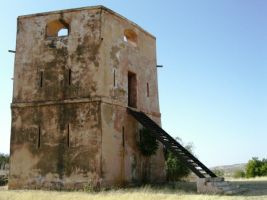
Medina, The Fortress – 27 dec 2007
This is the Mali’s first fortress built by the French at the beginning of the 1800s. There is also a nice train station, a lovely school (the first one in Mali), towers and a cemetery….a pretty little city on the river Senegal.
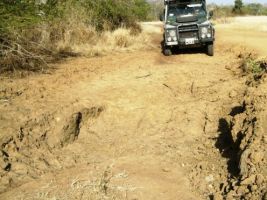
Track to Bamako – 27 Dec 2007
550 km of potholes is the alternative to the newly built asphalted road. It passes north through the village. We were torn between going quickly along the 600 km of straight asphalted road or the old road which passes south across the railway and the river.

The beauty of the first few kilometres sold it! So we opted for the pot holes and scenery….we never learn! In theory, it all sounded idealistic, but, the reality, usually - as we are slowly learning - is that a track in Africa means a lot of dust and wasted time. Not so much potholes as craters….and more…
Night falls and we spend it under a beautiful starry sky, surrounded by centuries old baobabs. In the distance there is the sound of drums (till 4 o’clock in the morning!) from the nearby village. They’re probably celebrating the next barbaric and prohibited infibulation ceremony.
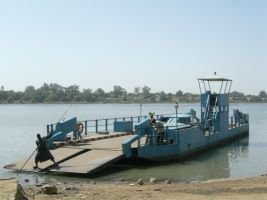
The next day we set off and are soon surprised to find ourselves by the river. …The river? This crossing wasn’t on our map and where is the bridge…there isn’t one! We do notice that there is a flat boat. We assume this to be a ferry. A timetable, there must be a timetable? Apparently not, that is, apart from the usual African one that no one actually knows.
It turns out that the engine is being taken to Bamako (350 km away) to be repaired. It also turns out that our pump that pumps diesel from the tanks has disappeared.
Meanwhile, something is coming…something called “bac”, powered not by an engine but bamboo poles. “We have seen you from the other side and thought you may want to cross the river” the old captain perceptively calls to us…he continues to impart to us his price…obviously included in his price is a contribution to his is personal pension fund. We are the only passengers and K7 is already on board.
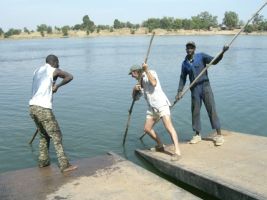
We then start to haggle. He makes it quite clear that they are in no hurry to leave, then neither are we! (I’m careful not to labour this flagrant fib). After a little time we are able to halve the price by giving away some “cadeau” and promising (jokingly!) that we will help push the ferry.
Soon after we embark we arrive at the point where two rivers merge together (Bakoi and Bafing) to form a single one: the Senegal river, the same one that joins the sea at St. Louis. We have now seen the beginning and end of this sizeable river.
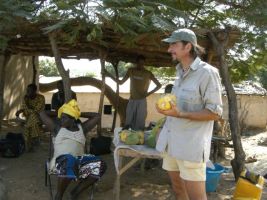
When we get to the other side, we exchange currency with a man selling lighters. There is a bank, but it does not exchange money! The lighter seller is wearing a blue, double-breasted suit completely covered in dust. He’s the only one who, for a generous fee, helps us out. We re-fuel at a petrol station with hand pumps. It isn’t worth putting the generator on for only 130 litres of fuel.
Then we wait for the train with a lady who sells papayas….
but where is the train?
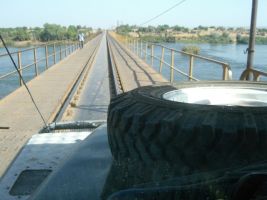
The road continues on the other side of the railway bridge.
This is the only way to cross the river.... obviously, when the train is not passing by...
The railway master gives the thumb up...and off we go!!
Kita – 27 Dec 2007
We get to Kita at night. We sleep in the Relais Turistique garden; the hotel in not very clean and has seen better days. There is also a disco, open till 4 o’clock in the morning, just before the Muezzin sends his message for prayers and the train passes-by whistling before and as it goes through the crossing (without barriers).
If you are desperate and do not know where to sleep these are the coordinates: GPS N13° 02.338’ W009°29.215’
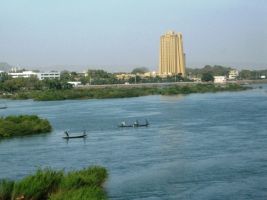
Bamako – 28 Dec 2007
Here we are in the capital! A lively city on the Niger river. First thing: the Visa to Burkina Faso. We go to the Consulate (which has now changed place) GPS N12°37.860' W008°00.870'. You will need 3 pictures, 3 applications and 28.200 cfa each. By evening we’ve got our Visas. Easy peasy. We stay at the Catholic mission in the centre: clean and cheap and you’re allowed to camp in their garden GPS N12°38.550 W008°00.220
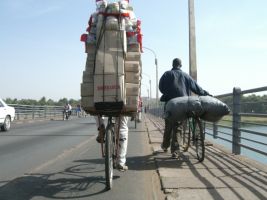
Mobylette and Bicycles
There are many mopeds, scooters, motor bikes, bicycles and carts. Driving through Bamako streets takes years off your life: this is due to stress and pollution. Everyone wears a mask. We decide to join the flow ride with masks as well.
Everyone carries loads on their bikes: we see a speeding motorcyclist balancing a precarious 80 kg load of pasta

New Years Eve 2008
We chose a renowned place for the music Le Hogoon, from the name of the spiritual chiefs from the Dogon population. Many musicians played that night, the most famous was T.Diabatè, a kora player… a mix between a guitar and an harp.
The music, the menu “a la cart” and the company were excellent (three Swedish guys and a German girl). Everything was great, apart from, it seemed they had catered for 5 and we were about 500!
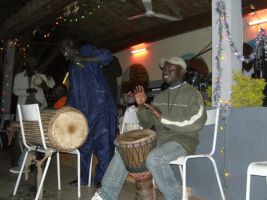
(I’ll leave the portions to your imagination). But hey! we are in Africa and it’s good to suffer a bit…At midnight…nobody said anything, no count down to the new Year, no fireworks…nothing. Not even a bottle to celebrate.… At 2 minutes past midnight, someone says over the microphone “we’re in the new year” ...then dancing and more music. At 4 o’clock in the morning we go to our Landy and we eat a “Panforte” and drink a chilled bottle of 1999 Spumante…well, in the end, what else could we do?.
Happy New Year!
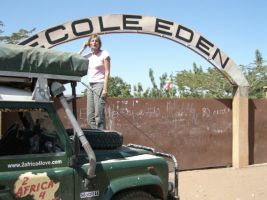
Mirjana’s child
We are travelling towards Segou. We have looked for EDEN, a school attended by a little boy who has been adopted by a friend of ours.
Solidarity account.
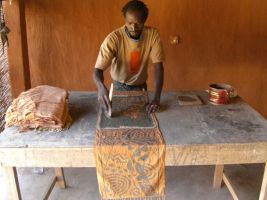
Segou – 2nd Jan 2008
City on the Niger River. We have seen how the locals make beautiful fabrics using mud paints: Bologon.
We camp in the garden of Hotel Independence; the hotel was recommended by tour guides and overlanders alike. Free entry to the swimming pool and a nice restaurant. Free WiFi.
GPS N13°25.800 W006°13.450'
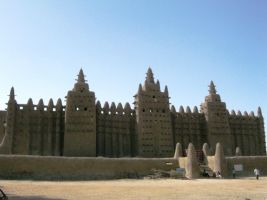
Dienne – 3rd Jan 2008-01-27
We take a ferry to visit the most famous Mosque in Mali. The scenery is exciting, but the atmosphere can be ruined by the locals who, when they spot that you are foreign, surround you, swarming like bees round a honey pot. Continuous and exhausting requests to help, guide, and to sell you anything at any price. From 6 years old onwards, …..except women!
You daren’t stop the car for a second, or someone comes along asking for money in exchange for looking after your vehicle. While you’re trying to explain that you’re just looking at your map, someone else comes along arguing that he is a real parking attendant...and so on and on.
We stop briefly, time just to catch the end of prayer and then we flee.
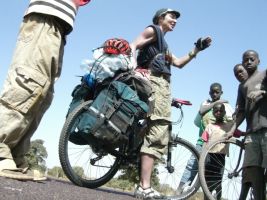
Angelica 3rd Jan 2008-01-27
Overloaded bicycle and a beaming radiant smile, she waves with enthusiasm at the kids, her arms and everything else she has exposed plastered in sun-cream. This is Angelica, an Italian-American girl who lives in London. She is on a 5 month ride across Mali on her bicycle. We exchange telephone numbers and wish each other “Good Luck!”.
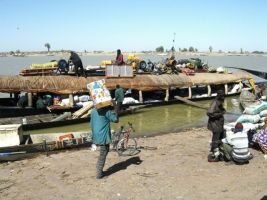
Mopti – 4th Jan 2008
A city on the Niger river whose economy relies upon it. Everything is transported to and from this small city by “pinasse” (a type of boat). From here you can travel by boat to Timbuktu. From Timbuktu slabs of salt and dry fish are brought and sold on local markets.
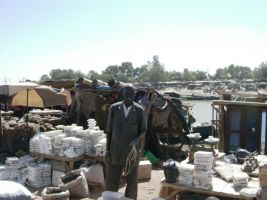
We don’t know whether to leave the car here and travel to Timbuktu by boat or not: it is uncertain exactly how long it takes. On some boats that carry goods, we are told that it takes between 3 to 6 days and will cost about 30 euros. For this you get nothing, just planks or bags of food to sit on. On the other hand, if you travel by “pinasse”, it costs between 100 and 200 euros, and a mattress and meals are included. No cabins, of course. Conventional boats can’t sail in this dry season, as there isn’t enough water in the river (the cost is the same as for the pinasse)
Once we get to Timbuktu, there are 18km from the port to the city. We will need to hire a vehicle and accommodation. In a few day’s time, a well known music festival will take place in the desert. We think this will probably mean that, it will be fully booked and quite pricy.
If we travel by car, we have 190km to cover on asphalted roads and a further 200km on tracks. It means 2 days, but then we’ll be independent with our own car and accommodation. Decisions, decisions!
The temptation to see the festival is big…while we ponder on this decision we spend the night in a catholic mission: central but not particularly well kept.
GPS N14°29.773’ W004°12.026’
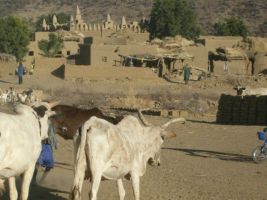
We stay with K7
We decide to drive to Timbuktu. Firstly, we do not want to end up without a place to sleep; secondly, every time you move, you need to haggle over the price. With K7, we are relatively safe.
Every village has its own mud mosque; some of them are particularly well kept.
We drive towards Borko, a small place where we can probably see crocodiles. The drive is pleasant; the road runs among rice-fields, rocky hills and tracks of arable land with small rivers. We arrive in the evening and find out that to see the crocodiles we will need the assistance of a “master of ceremonies” who calls them out. It costs 12.500 CFA, circa 20 euros. In these places, this is a ludicrous amount of money, if you think that a one-day guided visit to see the cliffs, costs 9000 CFA. We offer him 4000 CFA and he refuses. There is a French family with us and we both agree that we will not be overcharged. We decide we are no longer interested much to the villagers’ annoyance.
It is now dark and it is a 3-hour journey to the next village. The headmaster of a school nearby lets us camp in the schools’ unfenced ground for the un-reasonable price of 5000 CFA (are willingness to leave some school material we are carrying quickly fades!).
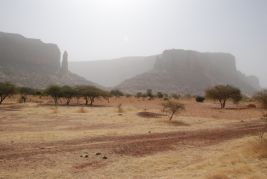
The next day we leave towards Mali’s “Monument Valley”, to see the cliffs between Douenza and Hombori. It was a pity that during the night, a strong wind lifted a thick layer of sand and dust: the Harmattan, a wind during the dry season that can blow for 3 months. Shame, we don’t get to see the panorama.
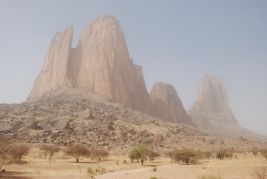
We get close to the more touristy part of Mali. On this road, there is a reserve of migrant elephants that live in a 1000km area. Every year they come here from Burkina. It is quite difficult to see them: we drive for hours with not even so much as a glimpse.
At a petrol station at the foot of the splendid Mano-di-Fatima rock, a 14-year-old boy tells us that he could take us to see the elephants at the cost of 30.000 CFA. We just smile……..
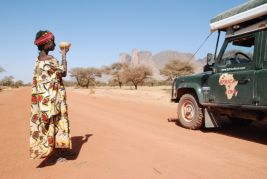
Track to Timbuktu – 7 Jan 2008
Here we are, on the track to the legendary Timbuktu! 200km of “tolle-ondulè”. Travelling South, it takes you to the heart of the Desert towards the Tuareg territory. Yawning, seemingly bottomless potholes are everywhere and are roughly 60cm apart. The vehicle bucks and keels, dismantling itself along with our vertebrae... They advise, that you should deflate your tyres to 2.1bar and drive at 60 kph. Everyone’s an expert, all with their own tips and modus operandi. We decide to follow the motorized locals way of doing, but in our Landy, as opposed to the ubiquitous Toyota pick-ups..
We take a nearby road “the official one”: sand, dunes, etc… In our own good time we proceed, somewhat gingerly, but, we do manage to average 30 kph…, and, we are not vibrating like a spin-dryer!
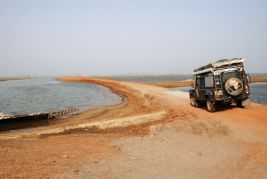
When we get to the end of the track, we do not find the city; only water. At this particular point, the Niger pushes itself towards the desert.
At the end of the first millennium, the Tuareg chose this place to build a seasonal village for their commercial activities: gold from the South, salt slabs from the North. A strategic place for a commercial cross-roads.
There is a “bac” to continue on our way. It costs 14.000 CFA. You can share the price if you go on with four cars (maximum load). In two and a half hours, we are on the other side (40 minutes to actually cross).
It takes us 7 hours to reach Timbuktu. We settle for the night at Kristien’s Caravanserai: very nice, clean rooms with bathrooms. You can sleep and camp on the roof. We opt for the camping at 2.500 CFA per night. First hot shower after one month. Restaurant, bar and live Tuareg music.
GPS N16°45.867 W003°00.592
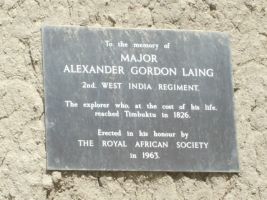
Timbuktu – 8 Jan 2008
Poor major Laing! What a disappointment it must have been wandering into the Timbuktu of 1826. After centuries of legends, extraordinary stories which have been the inspiration of many scholars, historians and researchers’ dreams. Timbuktu, the once holy grail, the city much sought-after by the many adventurers who paid the ultimate price during their quests. Expeditions and lives lost in forests and deserts. Following tracks mapped by mere voices. Tracked-down by tribes - Tuareg and Jungle - thirst, malaria, fading away into the eternal sleep, lost in the broken dreams of the legendary Timbuktu.
Here he is now. Alexander Gordon Laing, major of the second West India regiment. First European to walk the sunny streets of the prohibited city. Living amongst the dusty and declining buildings. Now, only libraries stock the rare and precious scripts concerning Laing. They tell of his greatness and refined culture. Stories of enlightened minds and Islamic philosophers who lived here long ago.
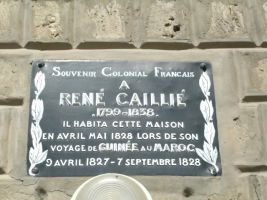
He never returned home to talk of his findings and his feelings or the excitement on his arrival. Killed on his way back home, it would be two years before Frenchman, Renè Cailliè, tells the west about Laing.
Shame that the city’s decline had already started 200 years ago and what remained looked exactly what you can still see today. The accounts of the 40 known explorers who tried to uncover and discover the city’s secrets – only four of which, reached the city – have made Timbuktu a feel touristy.
We walk around the city and visit the houses inhabited by these great explorers, trying to imagine their life back then.
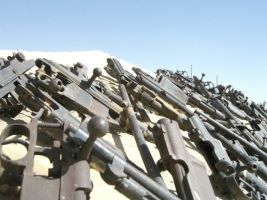
The only recent story worth mentioning is the Tuareg riot of a few years ago. Once the revolt was placated, the weapons that remained were used to build a memorial. What an irony!
Once was the city, throbbing with life…and the westerners, bandits sanctioned with the death penalty.
Today, poor people inhabit Timbuktu and it is the Europeans that give life back to the city. The musical festival that is due to start in a few days will give much needed revitalization.
There is an old Sudanese adage which is still used today…. “Salt comes from the North. Gold from the South. Money from white people. But the word of God and enchanting tales are only found in Timbuktu”.
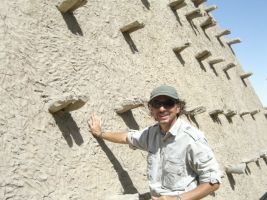
Four travellers (a Dutch couple travelling with a Land Rover 110 and a Dutch-Spanish couple with a Toyota 100) invite us to dinner. We accept their invitation and give them some Balsamic vinegar to try out. We have travelled on the same track and spend the evening sharing tips and one anothers’ experiences.
They decide to go to the music festival in the desert, 70km away. We are tempted, but the next day I have a temperature of 38.5° C. This removes any temptation. A temperature in this environment always makes you think of Malaria, but, my runny nose suggests it is just a touch of influenza and so we calm down.
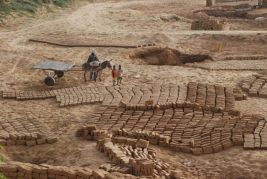
Douenza – 11 Jan 2008
In this passing village, we camp at Jerome’s Campement next to a brick factory . Jerome is a Frenchman with a great sense of adventure. He is the record holder of the Algeri-Cape Town race (8 days 11 hours and 44 mins). He has taken part in 17 Paris Dakar and is also a camel Trophy selector…he could go on for days.
Both tent and room accommodation are good and so is the restaurant.
GPS N15° 00,546’ W002°56.761’
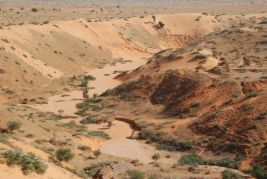
Towards the Dogon – 12 Jan 2008
We follow a track on Jerome’s advice which heads towards Dogon. No GPS. Estimated traveling time: 10 hours.
The track between Douenza and Bandiagara, 195km long, meanders among dunes and desert, cliffs and rocks, tilled land and villages. Millions of roads, crossroads and lanes. There aren’t any sign posts indicating village names. The GPS is only useful to make sure you’re not going back on yourself. We ask people for directions; people on bicycles, people driving carts full of wood, straw or just carrying their family….Young kids, mothers with children on their back, we ask so many…and there are many to choose from, there are people everywhere. However, here, people only speak in dialect, the French vocabulary is limited to “donne l’argeant” “Il faut che tu me donne cadeau”.”ça va, ça va bien”.
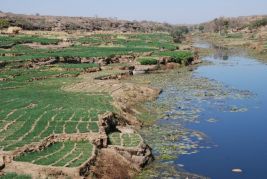
It isn’t easy, as we don’t have a common language we can both understand. Our maps are of no use, as they are unfamiliar with maps of this type and in most cases have probably never seen the like before. Quite simply, they don’t use or need them.…They know these tracks by heart. And they only know the names of villages within 50 km. Most of them have travelled no further. We put on our best accent and try to pronounce or at least make something that sounds like the name of the next village (in this case it is “Kaporokéné-Pe”), at the same time pointing in the approximate direction. Reactions and expressions are wide and varied, depending on the interlocutor you’re faced with.
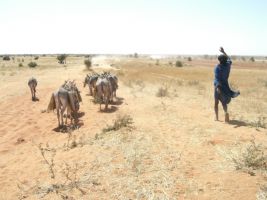
Donkey or zebu convoy traveller
He is usually smiling. He comes and he goes, and probably has no idea of the name of the place he is heading, or what he will be doing next. But he certainly knows the way and why. He knows the track, he knows it well, very well, just as his father and his forefathers did, because they traced it. He does not know a word of French but “argent”, which he utters with an outstretched hand as soon as we finish with our obvious mispronunciation! A complete waste of time!
“Kapo prochéneé-Pe”
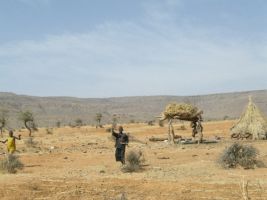
Men passers-by
Always ready to help you, they listen and nod carefully to what is said. They repeat what you have just said to them, nodding in unison. Cracked it! Sorted! Or so you think.
But this nodding continues no matter which direction you choose to point: east or west they nod like they couldn’t agree more! Perplexed, we finally decide to throw in the towel, when suddenly, they come out with a word that sounds just like the one you have repeated for the past 10 minutes. “Yes! Yes!” now we’re all nodding!!...And so, off we go again… we could spend the rest of our lives here...
Suddenly, it’s so clear, you understand, completely, no problem. Until, having covered just a few km, you soon begin to realize that, maybe, your understanding was in fact total misunderstanding. And now you are heading nowhere.
“Kaporopénépe-Re-pe”
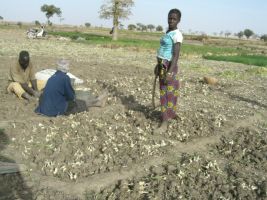
Women passers-by
Women usually stay close to the villages. Usually, they are walking whilst balancing something on the head with children following. They listen in silence to the strange strangled noise we make: “Kaporopeképe-Pe-pe”. They do not smile and look at us with intense, curious eyes. “Para poro képé-Pe??”. The children are now giggling. After having tried every possible way of pronunciation and pointed to every possible direction, our confidence in pieces, we begin to feel rather silly. What must they think of us? We can only imagine the thoughts behind those beautiful young African woman’s eyes. I imagine along the lines…. “Well, will you just look at this poor old toubab under this intense sun, ….with all his money and his fancy car (there isn’t a single car in the whole village)…instead of being at home, comfortable, with his running water and no mosquitoes…he takes time out to come here to entertain us and put a smile on our children’s faces with his strange, hilarious, well, we’re not quit sure what it is, or what it’s an impression of, but it sounds very funny”..
“Kaporopénépe-Re-pe”
We leave a bit disheartened. Never stop to ask women for directions!

Toubab Cadeau – Nursery rhyme
Tubaab!
Here comes the golden goose!
Its noisy car getting closer
I let go of the well rope
And run with the others to see
My gift is getting closer!
Inside a gift for me
Tubaab! Tubaab!
I leave the onions I’m uprooting
I stop working with the mortar
I leave the orchard running
Leave the well bucket bobbing in the water
Tubabo! Tubaab! Tubaaaabo!
I stop playing the game I am playing
I stop pushing the wheel I am pushing
I had stopped to do a woopsie, a number two, a poo-poo!
No time for that too! I gotta get a runnin’
‘Caus’ Tubabo! is a comin’.Tubaabo! Tubaaabo!
Boys and girls big and small
The young with the old, thin and tall
Snotty noses, clothes tattered and torn
Happy smiling faces hopeful and forlorn
Naked or in rags.
Tubab! Tubab! Tubab! Tubab! Tubab! Tubab!
I am running with the others!
I am greeting with the others!
I am screaming with the others!
Tubab! Tubaabo! Tubaaaaaaaaaaab!
Finally I arrive
In front of that car
Trying to sneak a look
Through the dust covered windows deposited by the wind
Inside I am trying to see
Inside a gift for me?
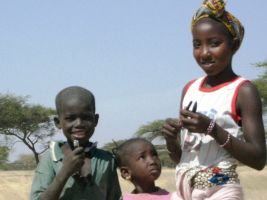
Give me – (a problem)
Give me a gift
Give me a pen
Give me a coin
Give me a watch
How about a sweet? Just a sweet.
The outstretched hand is always mucky, begrimed with food, soil, mud and dung.
It is a peremptoriness, desperate and at times a joyous scream. “I want a cadeau”, “you have to give me one”, “give me that one”, pointing and indicating to everything they see in the vehicle.
The Ministry of Tourism has two strong recommendations. Yes, just two, amongst the many that they could make they have only two, but they are strongly advised. They strongly advise you to use only authorized guides and to: “AVOID AT ALL COST GIVING GIFTS TO CHILDREN; COINS, PENS, SWEETS, ETC...”
They emphasize that this is the responsibility of all tourists! Help them educate their children. Try to avoid creating a population of beggars in exchange for just a tender moment, to see a smile on those beautiful faces from behind a secure car window. Resist this easy temptation, which ruins them. Let us make them smile, give them a hug and play with them. Give the pens and sweets to their parents and teachers so that they may be the ones to prize them at put them to good use.
Practically, this is a lot easier said than done, fine in principle.
However, in the Dogon villages, full of tourists, children between the ages of five and seven are becoming more violent if they do not receive a present, by throwing rocks at the car.
Our fault?
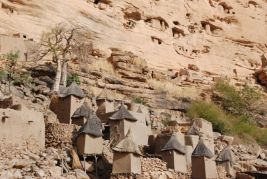
Dogon – 13 Jan 2008
Bandiagara is principal to the villages of the Dogon population. The locals of Bandiagara believe this to be so, but the Dogon people disagree.
We go to Sanga, where a trek will take place towards the attracting villages of Ireli, Banani, Bongo and Gongoli. We will visit the cliffs where the houses of the Tellem population are still visible. The Tellem people came before the Dogon. Since these houses were carved high into the rocks, the belief was that the Tellem people could fly. A guide here is compulsory, and you can get to know interesting stories about the population’s customs and traditions. There are some artefacts, stones and stretches of land that are considered sacred. It is not always easy to distinguish them, so it is very easy to commit an unforgivable sacrilege. The various paths that lead to the next villages are not marked; therefore, without a guide it is practically impossible to navigate.
Guides and services are expensive and you need to haggle to get a reasonable price. We have paid 25.000 CFA for a day guided tour, including taxes to enter the villages and the gifts for each village chief.
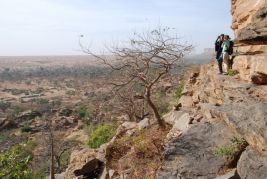
Dogon greetings
It is interesting to walk with a Dogon through a village. A monotonous song is sung repeatedly when two or more Dogon bump into each other and it lasts 5-10 seconds. But it could last longer. It depends on the willingness of the interlocutors and the respect they have for each other.
Here it is:
A) AGAPO (Good morning)
B) OH (to you)
A) SEO (How are you?)
B) SEO (How are you?)
A) UMANAN SEO (How’s the family?)
B) SEO (How are you?)
A) UNU SEO (How are your children?)
B) SEO (How are you?)
And so on and so forth with animals, houses, jobs, health…..
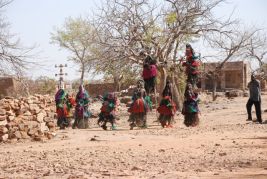
The weather was hot, but despite this, the day turned out to be very interesting. We learned about the population’s customs and traditions; for example, a house where women retire to, when they have their menstruation period; the part of the village where the wise men resolve their diatribes; wedding and funeral traditions; other sacred ceremonies; spiritual chiefs and wise old men who interpret the fox’s paw prints to predict the future….You need to spend more time here to understand all this and more
Unfortunately, guides, shops and services are very expensive.
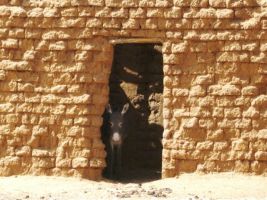
MALI – Our impressions
Mali is a lovely country, which can be covered in two weeks. The most interesting part is near the village of Douenza. Landscapes vary from desert to rice fields. This variety is shared by the locals - from Tare to Dagon, and more. In the more tourist areas, the phrase “I’m not interested” is simply ignored. Sometimes this can be very exhausting, more so at times, than the like of which we came across in North Africa. This hankering after money keeps prices very high and, at times, the service quite poor.
Main roads to the villages are well kept and very soon they will all be asphalted. There is a strong police presence, but this does not cause a problem for foreign travellers. A few road-blocks. Customs is usually quick and courteous.
